Last Updated on: February 5, 2025
Oklahoma’s location in the middle states is a vantage point for its bird life because it hosts some species only found in the east plus western birds. Also, since it’s close to the south, where some birds winter in Texas and Mexico, you’re likely to see some avians you may never find in the northern states.
Amazingly…
It’s home to almost 500 species, so there’s a chance of spotting a couple of them daily.
Therefore, let’s list birds of Oklahoma that visit bird feeders and mention other birds in the same species or group so you can differentiate them.
Birds Of Oklahoma That Visit Bird Feeders
Oklahoma has four mountain ranges and one of the tallest hills in the world, the Cavanal Hill. Further, it has natural forests, canyons, and over 500 waterways comprising creeks and rivers.
This rich flora sustains birdlife, meaning avians will come to your bird feeder wherever you live in this state. Let’s look at some of the backyard birds you should expect.
1. Barn Swallow
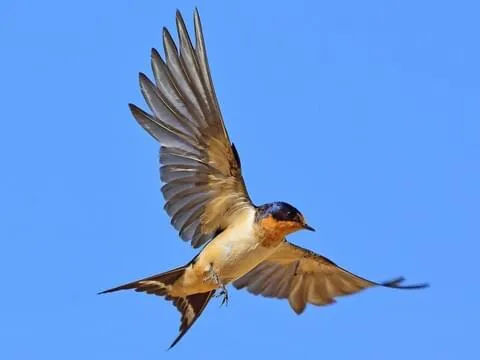
Barn swallows are common backyard birds in Oklahoma during their breeding season as this state and most parts of North America host breeding birds. These swallows have a bluish back and a tawny underside. Their backs aren’t a deep blue color like eastern bluebirds. On average, these steely blue swallows grow between 5.9 and 7.5 inches long.
You’ll see them in barns and fields, hunting flying insects. They fly close to the ground, so you’ll rarely miss sighting them if they’re in your backyard.
To attract more barn swallows, offer suet and bird seed, grind some oyster shells and leave them in a platform feeder, leave your barn door open for swallows to build nests inside, and create a mud pool as that’s the best source of building materials for this species.
One strange habit unmated males have is killing nestlings so that the pair breaks up and it gets a mate.
2. Downy Woodpecker
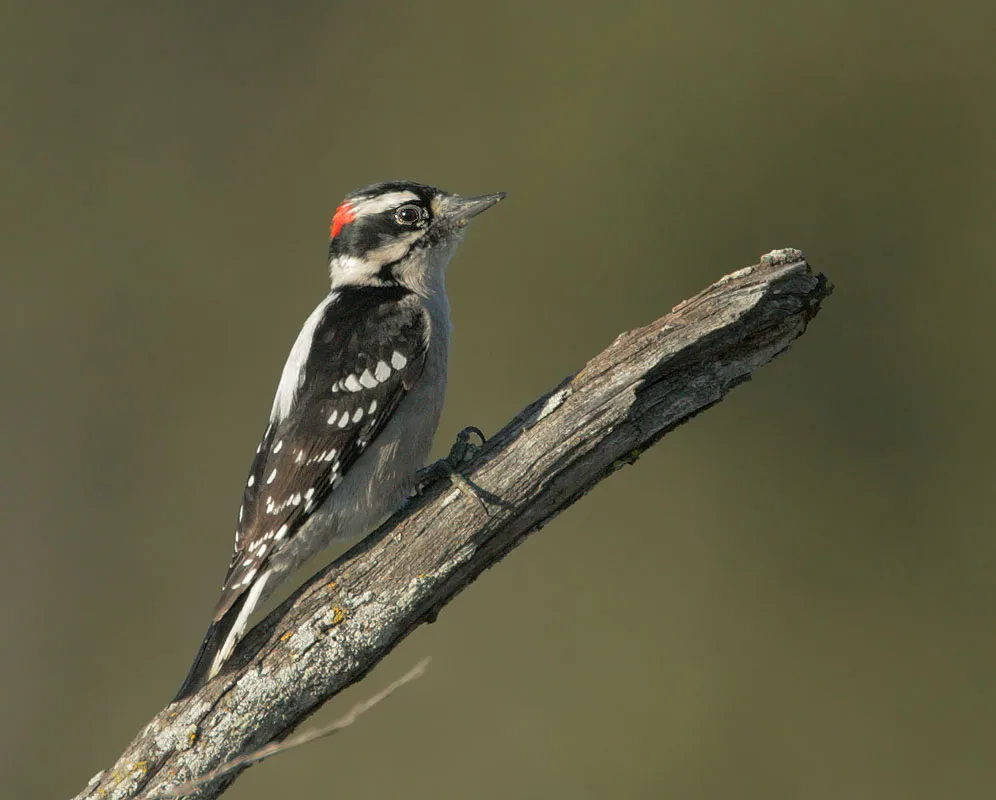
The bird on your lawn flaunting black and white stripes across its face and a red patch on the back of its head is a downy woodpecker. It also has white spots on its black wings and outer tail feathers.
Downys may come to your backyard after exploring deciduous forests and parks, looking for insects and berries. This bird isn’t picky as it eats various bird foods ranging from hulled sunflower seeds to safflower, peanuts, and mealworms.
Do you know how many woodpeckers are in Oklahoma? You can spot 15 of the 23 species in the U.S. Therefore, expect more woodpeckers than just the downy woodpecker. You’ll see its close cousin, the hairy woodpecker, the red-headed woodpecker, and the yellow-bellied sapsucker.
3. Eastern Bluebird
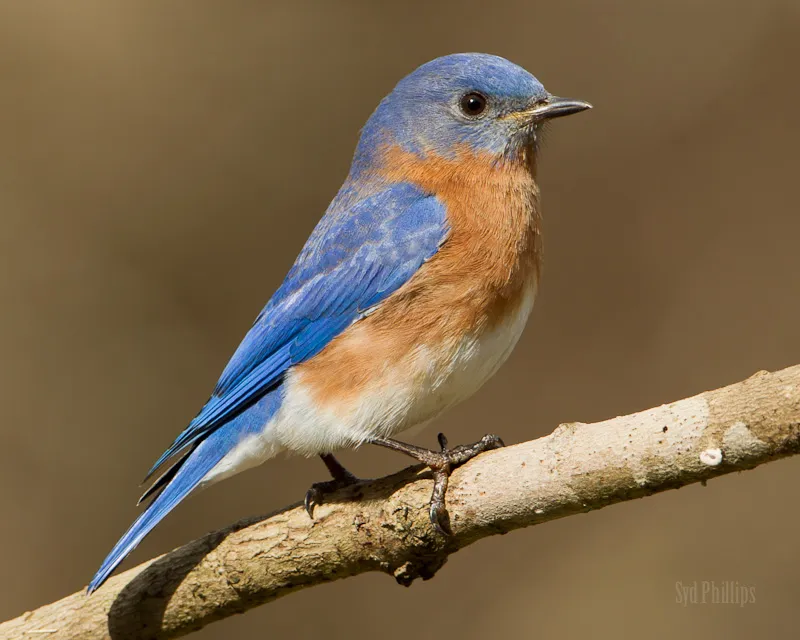
As we mentioned in our introduction, living in this state has its perks for bird lovers because you’re in the middle of the U.S. Well, the eastern bluebird is one species that expounds that statement because this state is within the boundary of the bird’s resident range.
It’s a colorful bird that many birders hope to see at least once, and the lucky ones are the ones living east or north where eastern bluebirds breed. This migrant species can fly over 2,000 miles from Canada to winter in Texas, although some birds stay in their breeding or resident range throughout the year.
Their tiny 6.3 to 8.3 bodies can fit inside small homes; thus, you probably have some bluebirds in your backyard if you have nest boxes. Have you spotted birds with a deep blue back and a rusty underbelly? Females aren’t as bright on the back as males because they have gray backs and bluish wings. Their underbellies have orange-brown plumage on the breast.
In addition to eastern bluebirds, you’ll also see the western and mountain bluebirds, so learn how to differentiate them.
Quick cheat sheet: A male mountain bluebird has sky-blue plumage with a darker back, while a male eastern bird has a rusty breast, as described earlier. Additionally, an eastern male has an orange throat, while a western bluebird has a blue one.
4. House Finch
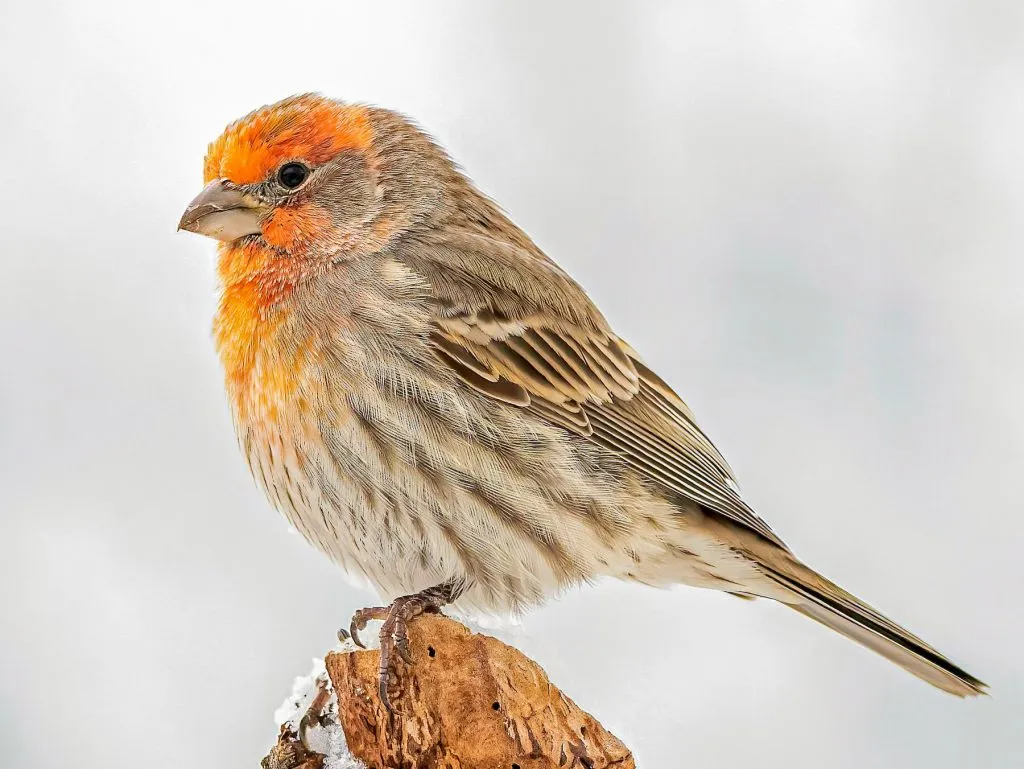
This non-migratory bird comes to bird feeders every month of the year. It can be a nuisance when it builds a nest in your wooden structures or any crevice on a wall. Its range was originally in the western states, but it’s now one of the widespread non-native birds occupying a greater area than the purple finch.
Don’t expect to see a large bird as a finch is about 5.1 to 5.5 inches long, about the size of a house sparrow. It’s easy to tell a house finch from a sparrow because a male finch has a rosy breast and face. It gets this pigment from food, and the intensity depends on the amount of pigment in the food.
Since females want males that can sustain nestlings, they go for the most pigmented males.
Fortunately, you’ll also see other finches like the purple and Cassin’s finches in Oklahoma. We’ll discuss that in our FAQs later.
5. Red-bellied Woodpecker
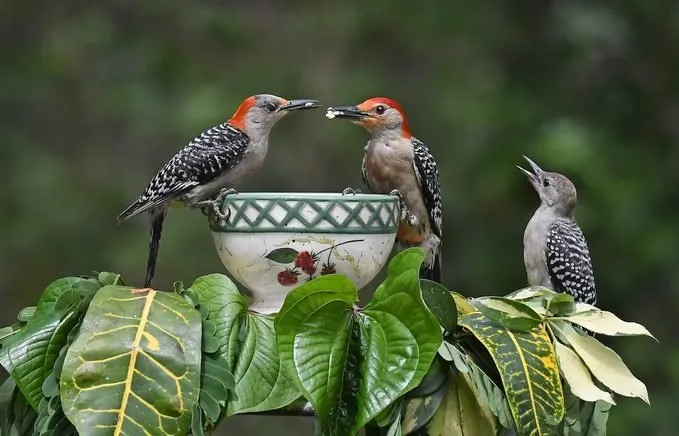
Have you seen a red-bellied woodpecker before? The males have a bright red head from the forehead to the neck and barred back feathers. The belly isn’t as colorful as it has pale plumage. A red-bellied woodpecker is about 9.4 inches long, so expect a bird about twice the size of a downy woodpecker.
The only difference between male and female red-bellied woodpeckers is the coloring on their heads, as a female’s crown is as pale as its belly, unlike the male bird. Their wild habitats are hardwood forests with hickory or oak trees. But, they are regular backyard visitors that also frequent city parks.
If you see a bird with the plumage colors described above, set up a suet feeder or give it some peanuts and black oil sunflower seeds.
6. Blue Jay
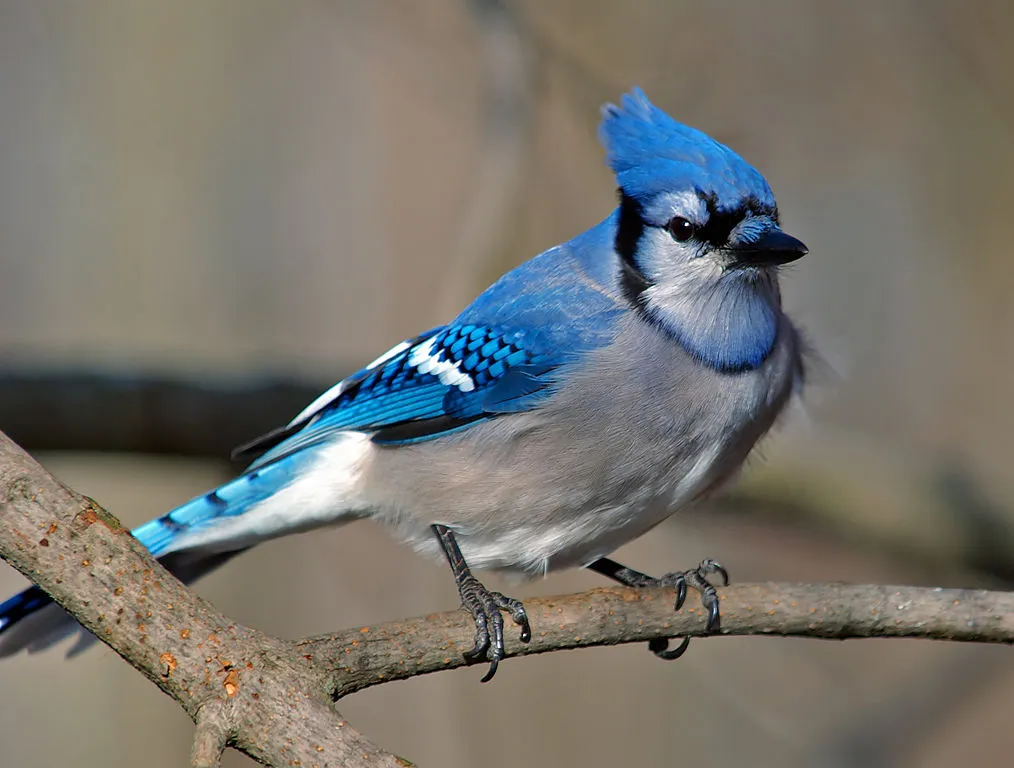
If there’s a species you need to capture on camera in your backyard, it’s the blue jay. It’s stunning! It has a blue back with black barring, a white underbelly, a blue crest, and a back necklace on the male.
Oklahoma is in the resident range; therefore, you’ll see at least one blue jay every day of the year.
Blue jays aren’t birds to ignore as they are loud whenever they drop by for whole peanuts, corn, or sunflower seeds. The best bird feeders for this species are suet cage, ground, or large tube feeders.
When they leave bird feeders, blue jays fly in flocks to forests with oaks because they love acorns. They also eat insects and nuts. Unfortunately, nestlings and bird eggs are on their menu too. Lastly, Oklahoma also hosts a close cousin of this jay, Steller’s jay.
7. Northern Cardinal

The northern cardinal is one of the common birds in Oklahoma because this state is in its resident range. Consequently, you’ll have northern cardinals in your backyard throughout the year, and it’s only wise that you know how to identify them.
The most distinctive feature of a northern cardinal is its upright crest. Males have red bodies, black masks, and throats, while females have orange-brown plumage.
To attract more northern cardinals, offer their favorite foods like corn, safflower, peanuts, and sunflower seeds. Their thick, short bills crack such seeds. They prefer trays and hoppers as they’re ground feeders, and you can also install a birdbath to give them fresh water whenever they need it.
8. House Sparrow
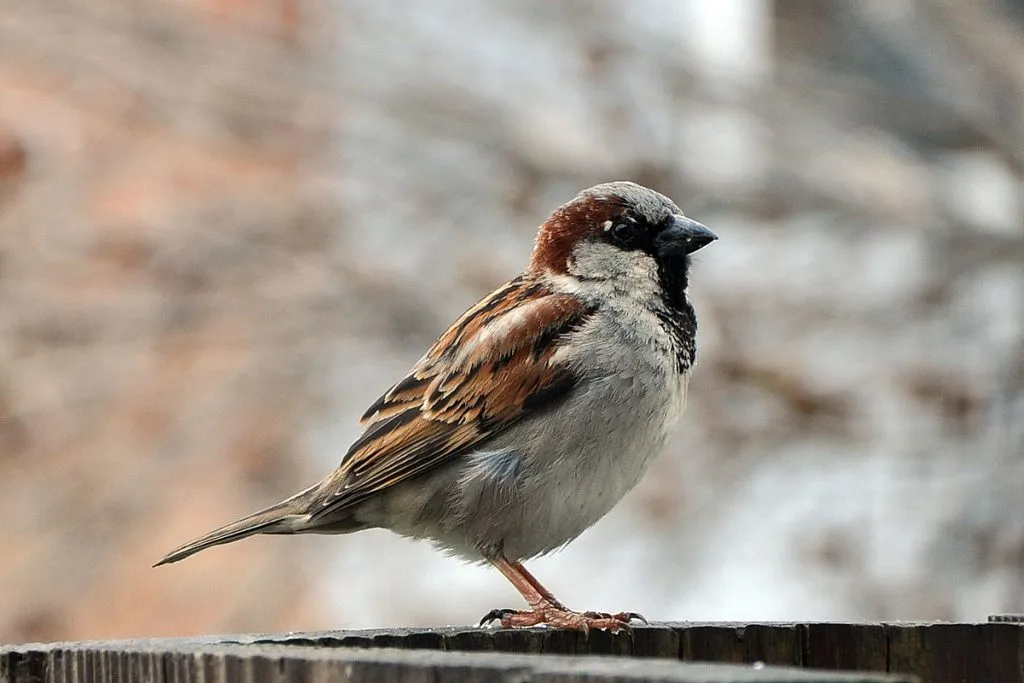
This species doesn’t mind how close you get to it, as it has adapted to human presence. It’s one of the most common birds in North America, with a resident population everywhere except the northernmost area. It’s invasive, so it’ll take over your backyard and even build nests.
House sparrows eat insects, seeds, weeds, and grains. In your backyard, you can offer seeds, millet, or milo. Their feeder choices are as diverse as the foods they eat because you can feed them on a window, platform, ground, or hopper feeder.
Oklahoma has over 20 sparrow species in addition to this one. You might confuse a house sparrow with a Eurasian tree sparrow or a white-throated sparrow. Here’s how to differentiate them.
First, a male house sparrow has a dark gray crown, white cheeks, a buffy and streaked back, plus a grayish underbelly. Females have buffy-brown bodies and grayish brown underbellies. On the other hand, a male Eurasian tree sparrow has a dark spot on its white cheeks, while a white-throated sparrow has a long tail, a small orange bill, and bold stripes on its head.
9. Mourning Dove
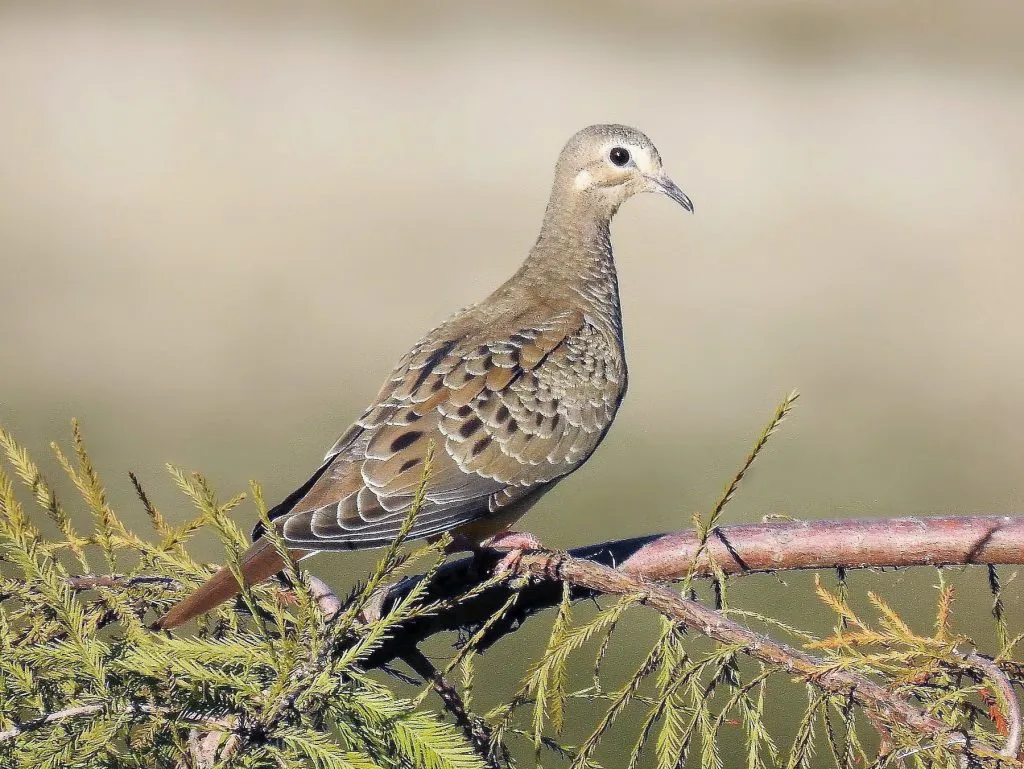
This common backyard bird is a seed eater; therefore, it’ll eat most feeder foods, from sunflower seeds to cracked corn. A mourning dove has a grayish body with black spots on its wings and pinkish legs tucked under its plump body.
There aren’t many doves in this state. In addition to mourning doves, you may spot the white-winged, Eurasian-collared dove, common ground, and Inca doves. Of these, the mourning dove is the one most birders know. The main difference between it and the Eurasian-collared dove is a black collar mark on the Eurasian bird’s neck.
Lastly, mourning doves got their name from their mournful calls that resemble those of owls.
10. Dark-eyed Junco
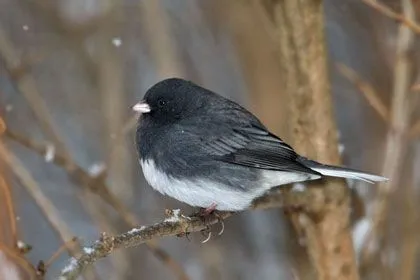
This tiny sparrow is between 5.5 and 6.3 inches long, about half the size of a robin. Its color pattern varies; however, the eastern birds are generally gray, while the ones in the west have a combination of black, white, and brown plumage.
Dark-eyed juncos eat seeds and insects, so stock your feeders with mealworms, black oil sunflower seeds, and millet. You might see birding journals calling them snowbirds because they are winter visitors.
The resident birds are in parts of the western states and the far eastern edge. The rest of North America hosts wintering birds. When a dark-eyed junco mates with a white-throated sparrow, the nestling resembles a sparrow and has white outer tail feathers.
11. Red-winged Blackbird
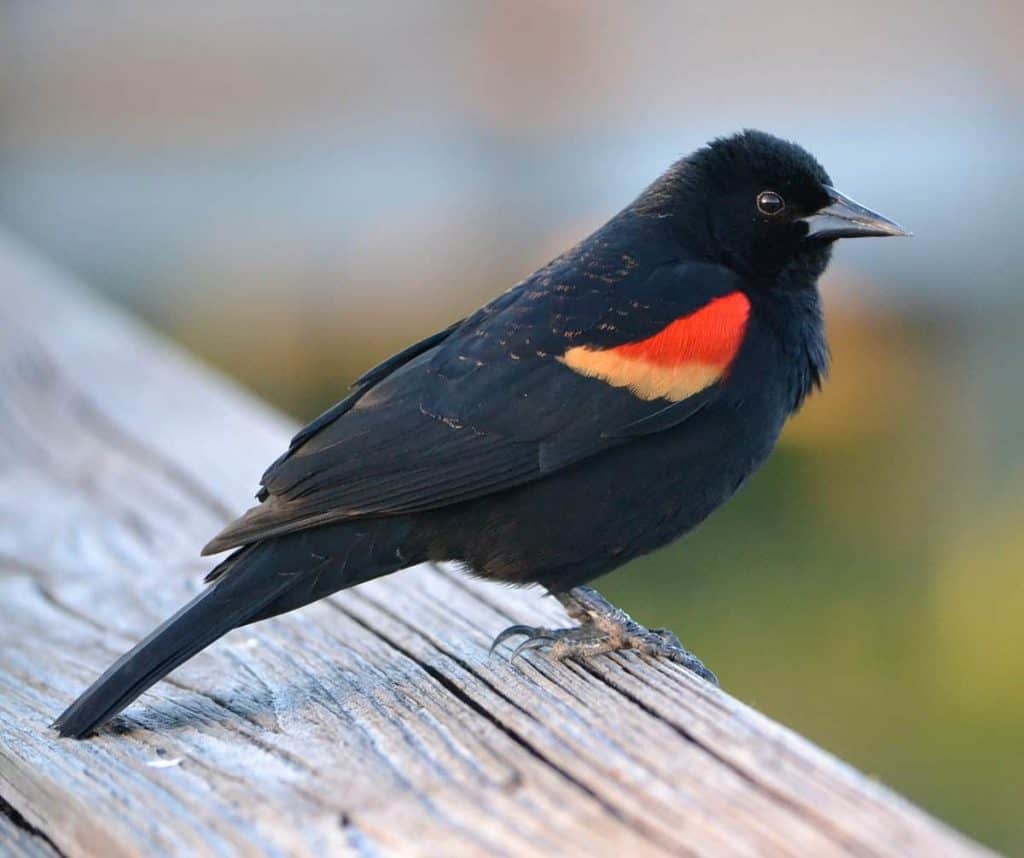
Its plumage is different from other backyard birds in Oklahoma because instead of contrasting colors on the upper and underparts, a male red-winged blackbird has a black body with orange shoulder patches. Female birds have streaked bodies and a yellowish bill.
You’ll often see this species perched on a tree or post in your backyard, watching its territory. The male is aggressive and defends its territory even from pesky humans.
The red-winged blackbird is a resident bird in the United States, with a preference for grasslands and farm fields during the non-breeding season. Sometimes, it joins a flock of common birds like grackles and starlings.
12. American Robin
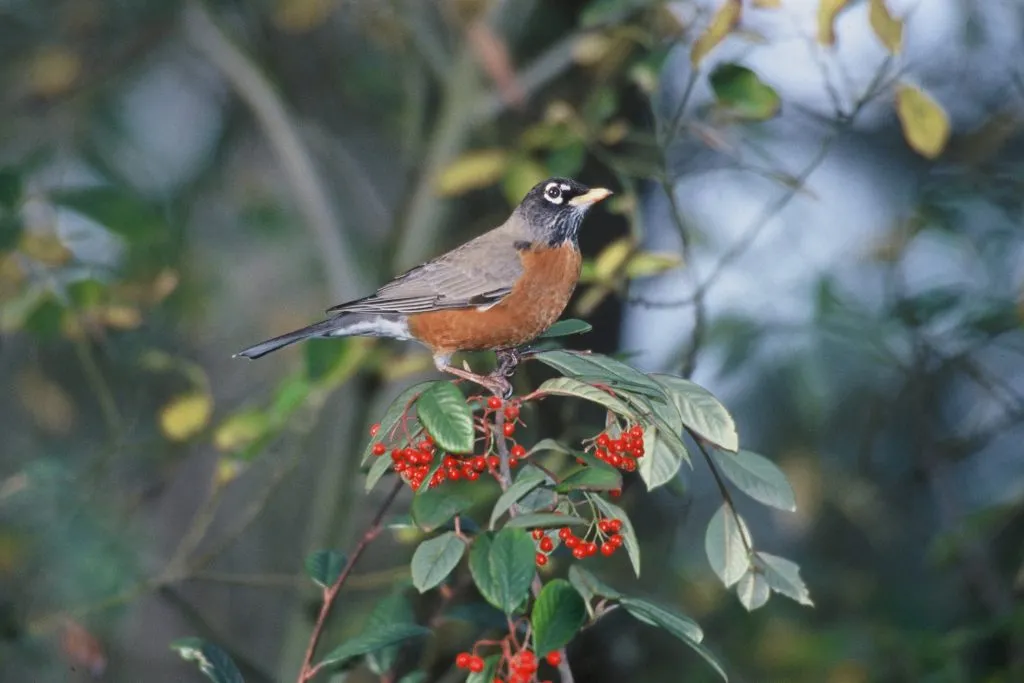
Three features differentiate a robin from other common birds: a whitish eye ring, rusty breast, and a dark back. Females have the same color pattern but are paler.
Robins are everywhere, from the tundra to forests. These inquisitive avians aren’t scared of humans, so they hang around parks as long as necessary. Seeds won’t keep them in your backyard. Do much more and plant trees that attract invertebrates like insects. Once there are earthworms or snails on your lawn, you’ll see more robins in the grass.
They might even be so comfortable that they decide to nest in your yard. That’s when you’ll notice cup-shaped nests with up to five bluish eggs.
13. European Starling
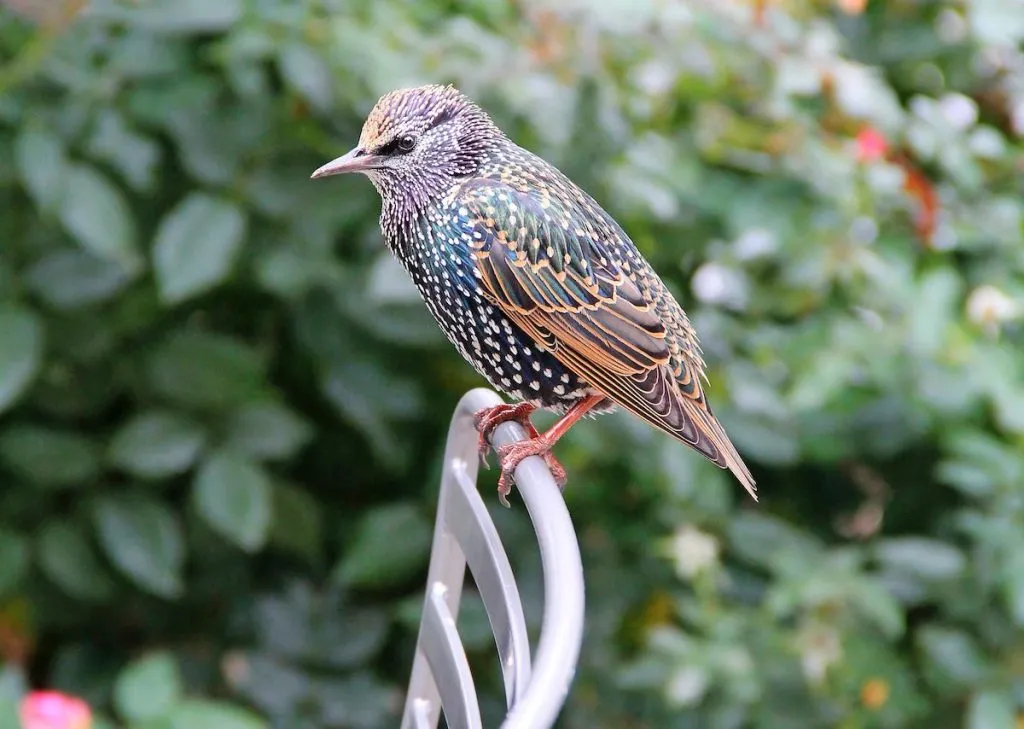
Summer and winter birds have different plumage. In winter, the glossy green-purple tint fades, they get white spots, and their bills darken.
The only states in North America without European starlings are Texas and southern California, where wintering birds live. The rest of the region has to withstand a starling’s great and not-so-good vibes.
It’s an excellent species to host in your backyard because starlings eat spiders, beetles, and insects. Their nestlings also eat larvae and insects. However, it’s a not-so-good visitor because it’s an aggressive bird that arrives in flocks and attacks other birds at the feeding station.
Starlings also nest in any cavity, from nest boxes to natural tree cavities, which can turn away tiny birds unable to fight this invasive species.
14. Carolina Chickadee
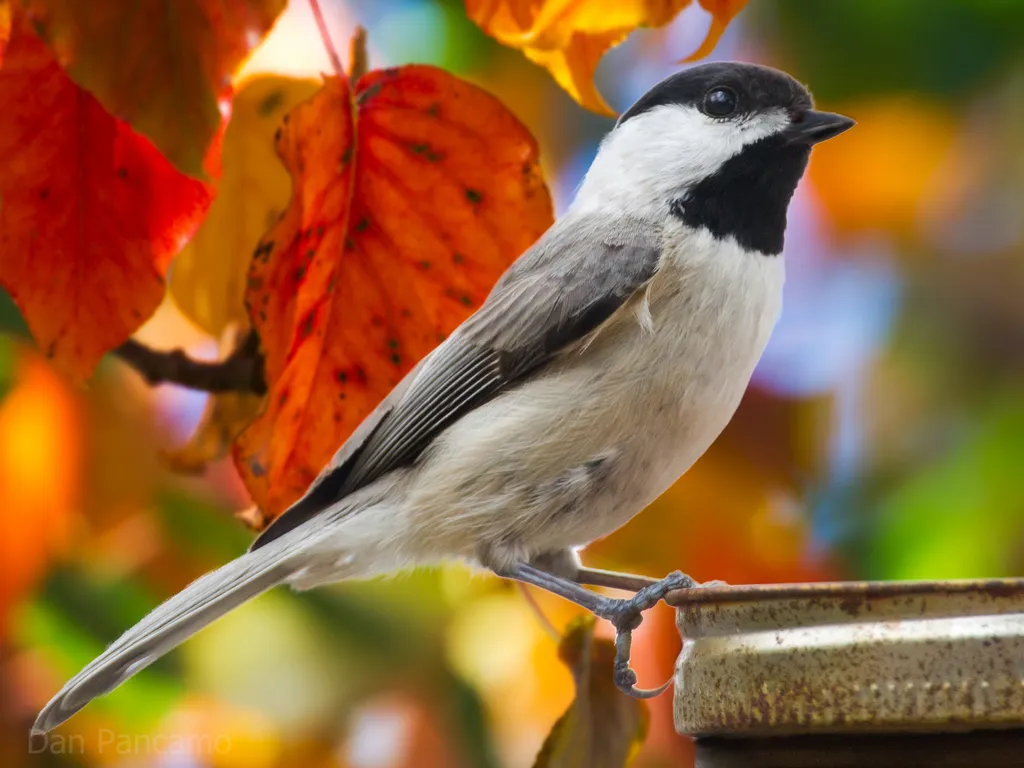
Carolina chickadees are in the same family as black-capped chickadees; hence, they almost have similar plumage.
It’s possible to confuse them where their ranges overlap. The black-capped chickadees are more in the western and northern areas of North America, and the two species overlap on the northern border where the habitat of the Carolina chickadee starts.
One of the ways to tell them apart is by their song because a black-capped bird has a lower pitch and slower notes. Strangely, when the range overlaps, any of the two birds can learn how to sing like the other.
When that happens, you need another way to identify them. Here’s what you can check. The wing coverts of a black-capped have a white edge while those of a Carolina bird are grayish.
A Carolina chickadee eats insects, berries, and seeds. You can feed it in many feeders, such as a large tube feeder, suet cage, hopper, or window feeder. It’s non-migratory and inhabits the eastern and midwestern states, so you’ll see it in Oklahoma.
15. Carolina Wren
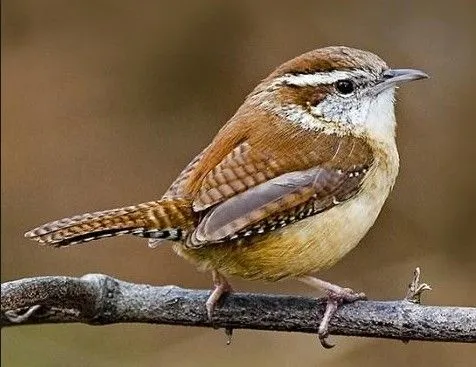
This wren is likely to visit your suet feeder in winter or to take shelter in your nest box because it is sensitive to cold weather.
Oklahoma has many wrens in addition to the Carolina wren. They include marsh, rock, house, and winter wrens. To know you’re looking at a Carolina wren, look for an avian smaller than a sparrow, with a reddish brown back, white throat, and a buffy underbelly.
It loves exploring piles and backyards, looking for insects and fruit. You might see it foraging in brush piles. It’s one of the few birds found only in the eastern states, which means you’re lucky to have it in your backyard in Oklahoma because it’s not even on the western side of this state.
16. Brown-headed Cowbird
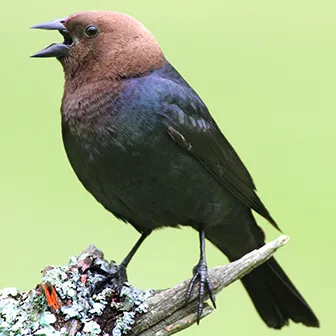
Male and female brown-headed cowbirds have different plumage, with a male displaying a black body and a brown head, whereas a female has a brown body with some streaking on the belly.
Oklahoma is in the resident range, so if it doesn’t come to your backyard, you can go looking for it in grasslands or woodland edges.
You might notice the parasitic habit of the brown-headed cowbird, where it lays eggs in another bird’s nest. You’d expect a bird with parasitic habits to be large and dominate other birds, yet a brown-headed cowbird is 7.5 to 8.7 in long, which makes it smaller than a red-winged blackbird.
17. Ruby-throated Hummingbird

This stunning hummingbird should come to your bird feeder so you can take in the beauty of its iridescent green back and red throat. That’s the plumage color of a male hummingbird. Although females are duller with pale green backs and white bellies, they’re also interesting to watch as they fly excitedly around your hummingbird feeders.
Oklahoma has many hummingbirds; hence, set up that hummingbird feeder ASAP! In addition to the ruby-throated hummingbird, you may spot the rufous, calliope, blue-throated, and Rivoli’s hummingbirds.
The eastern side of Oklahoma is within the breeding range of ruby-throated hummingbirds, while the western side is on the migration route to wintering grounds south.
Watch This!
Frequently Asked Questions
What is the rarest bird in Oklahoma?
The almost extinct ones are the ivory-billed woodpecker and the Eskimo curlew.
Several other rare species sighted in this state include the whooping crane and the white bald eagle.
The south polar skua also sighted in this state, is one of the rarest birds in North America. Its six days in Oklahoma drew birders from different states.
How many species of birds are in Oklahoma?
As of March 2022, there were 487 recorded species. There are two extinct species, the passenger pigeon and the Carolina parakeet. The Passeriformes order is the largest in Oklahoma, and it has families of the starlings, sparrows, crows, wrens, and thrushes. You’ll also see many birds of the Anseriformes order, which consists of families of ducks and swans.
What birds stay in Oklahoma in winter?
Winter birds include the Pacific loon, red-breasted nuthatch, purple finch, pine siskin, and various blackbirds. It means you can keep your feeders out even in winter as you’ll have plenty of visitors.
Are finches in Oklahoma?
Yes, there are many finches, including the American goldfinch, lesser goldfinch, Lawrence’s goldfinch, and others we mentioned when discussing the house finch.
Conclusion
Common backyard birds in Oklahoma visit in summer and winter. This state has many resident birds that visit your feeding station throughout the year, while others fly in during their breeding season.
The wide range of species also means you need several feeders and bird food. Suet, sunflower seeds, peanuts, and corn are the favorites for many birds but don’t forget some species like robins love insects, so you need to grow grass for earthworms to thrive. Plus, install a suet cage and a hummingbird feeder.

